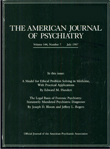Mood Improvement Following Daily Left Prefrontal Repetitive Transcranial Magnetic Stimulation in Patients With Depression: A Placebo-Controlled Crossover Trial
Abstract
OBJECTIVE: Preliminary studies have indicated that daily left prefrontal repetitive transcranial magnetic stimulation might have antidepressant activity. The authors sought to confirm this finding by using a double-blind crossover design. METHOD: Twelve depressed adults received in random order 2 weeks of active treatment (repetitive transcranial magnetic stimulation, 20 Hz at 80% motor threshold) and 2 weeks of sham treatment. RESULTS: Changes from the relevant phase baseline in scores on the 21-item Hamilton depression scale showed that repetitive transcranial magnetic stimulation significantly improved mood over sham treatment. During the active-treatment phase, Hamilton depression scale scores decreased 5 points, while during sham treatment the scores increased or worsened by 3 points. No adverse effects were noted. CONCLUSIONS: These placebo-controlled results suggest that daily left prefrontal repetitive transcranial magnetic stimulation has antidepressant activity when administered at these parameters. Further controlled studies are indicated to explore optimal stimulation characteristics and location, potential clinical applications, and possible mechanisms of action. (Am J Psychiatry 1997; 154:1752–1756)



